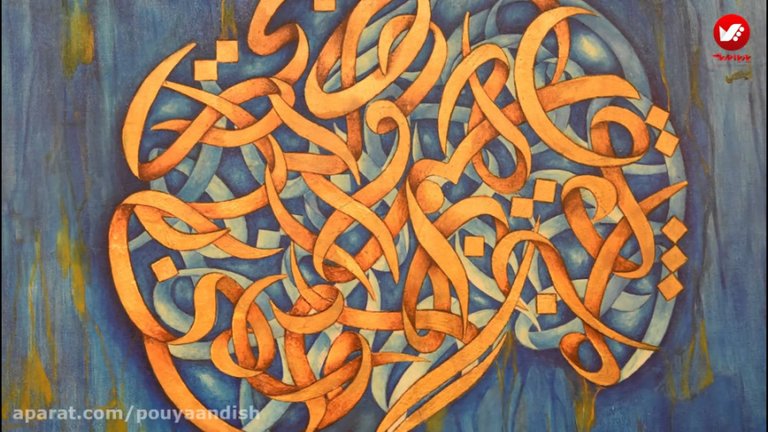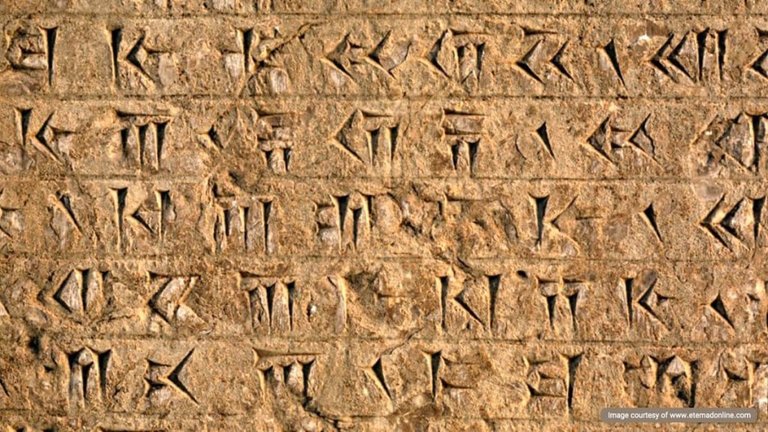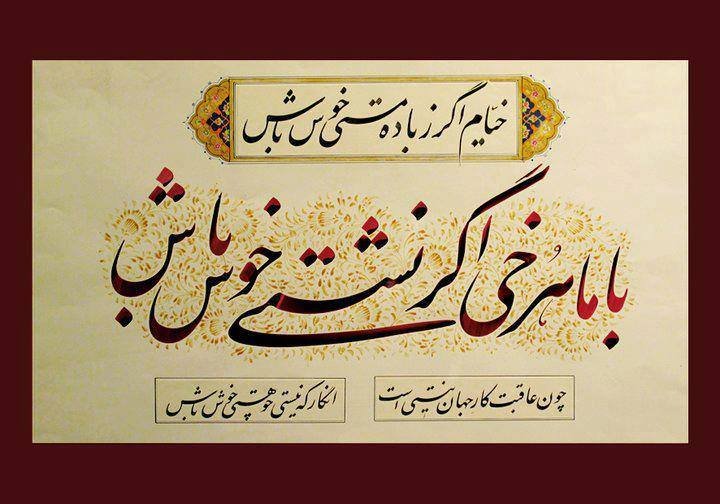سلام و درود دوستان و همراهان خوبم،
Hello and greetings my dear friends and followers,
امروز خواستم به زبان خودم یه پست بنویسم و تصمیم گرفتم این مطلب رو در بخش نویسندگان آزاد منتشر کنم، چون بقیه بخشها به نظر میرسه که مناسب چنین پستی نباشن.
Today, I wanted to write a post in my own language and decided to publish it in the Freewriters' community because the other communities didn’t seem suitable for a post like this.
در واقع داشتم به این فکر می کردم که توی این پلتفرم زبان نوشتاری ما ایرانی ها دیده نمیشه، یا اگر هست خیلی کمه، شاید باز هم از این مطالب بنویسم برای اینکه دوست دارم مردم کشورهای دیگه با زبان ما آشنا بشن، در واقع این مطلب رو من برای مردم کشورهای دیگه دارم می نویسم.
I was actually thinking about how the Persian writing style is rarely seen on this platform, or if it is, it's very limited. Maybe I’ll write more of these posts because I want people from other countries to become familiar with our language. In fact, I’m writing this for people from other countries.
The photo above showcases traditional Iranian/Persian calligraphy (A Poem by Omar Khayyam), though it can also be more complex like this one below:
Image Source

زبان فارسی یا پارسی یک زبان خیلی قدیمیه و ادبیات و شعر بسیار قویی داره، هرچند به اندازه ای که باید تبلیغات نداشته و ممکنه خیلی ها در موردش چیز زیادی ندونن و فکر کنن که مثلا در خاورمیانه همه زبانها مثل عربی هستند.
اگر بخوام این جریان رو با یک مثال توضیح بدم می تونم اینطوری بگم که شما فکر کنید که زبان نوشتار یک فرانسوی و اسپانیایی و انگلیسی و آلمانی چه تفاوتی با هم دارند؟ از نظر حروف الفبا میشه گفت حدود 80 یا 90 درصد مشابه هستند و ممکنه توی بعضی زبانها روی بعضی از حروف نقطه بذارند. خوب جریان نوشتار فارسی و الفبای فارسی هم همینه، فارسی و عربی و حتی اردو که زبان پاکستانی و افغانی هستند از نظر نوشتاری تشابه دارند به هم. ولی مثلا بین زبان های اردو و فارسی و عربی تفاوت ها در حدی هست که ما نمی توانیم متنهای یکدیگر را بدون آموزش زبان بفهمیم. مثلا می خوام یک مثال بزنم به 3 زبان:
Persian (or Farsi) is a very ancient language with a rich literary and poetic heritage. However, it hasn’t received as much promotion as it deserves, so many people might not know much about it. Some might even assume that all languages in the Middle East are like Arabic.
To explain this concept with an example, let’s think about how French, Spanish, English, and German writing systems differ. In terms of the alphabet, they are about 80–90% similar, with some languages using additional dots or accents on certain letters. The same is true for Persian, Arabic, and even Urdu—the languages spoken in Pakistan and Afghanistan. They share similar scripts, but the differences between Persian, Arabic, and Urdu are significant enough that we cannot understand each other's texts without learning the language. For example, let me show the same sentence in three languages:
فارسی: امروز روز خوبیه و من خیلی خوشحالم.
عربی: اليوم هو يوم جيد وأنا سعيد جدًا.
اردو: آج کا دن اچھا ہے اور میں بہت خوش ہوں۔
Persian: امروز روز خوبیه و من خیلی خوشحالم.
Arabic: اليوم هو يوم جيد وأنا سعيد جدًا.
Urdu: آج کا دن اچھا ہے اور میں بہت خوش ہوں۔
English translation: Today is a good day, I am very happy.
از اونجایی که ما ایرانی ها در مدارسمون بهمون زبان عربی هم درس داده میشه و حتی کتاب الهی عربی هم درس داده میشه، من می تونم حدوداً بخشهایی از متن عربی رو متوجه بشم. ولی بدون آموزش هیچی متوجه نمیشم. و وقتی میرم سراق زبان اردو که فقط یک لغت مشترک میبینم و بقیه لغاتش به زبان هندی و لهجه هندی شبیه، احتمال میدم که زبانشون تحت تاثیر زبان هندی قرار داشته و با فارسی هم کمی ترکیب شده.
Since Arabic is taught in Iranian schools, including religious texts in Arabic, I can understand parts of an Arabic sentence. However, without formal education, I wouldn’t understand it fully. When it comes to Urdu, I only recognize a few common words, while the rest resemble Hindi in vocabulary and pronunciation. This suggests that Urdu has been influenced by Hindi while also incorporating elements of Persian.
یه جورایی میتونم بگم در تمام دنیا بین زبانها وام گرفتن از زبان دیگر وجود داره و حتی در دنیای مدرن وقتی یه وسیله جدید ساخته میشه اسمش رو از کشوری که داخلش تولید شده برمیدارن. این جریان بین زبانهای خاورمیانه هم بوده و بین چند زبانی که مثال زدم از زمانهای خیلی دور تا به حال کلی وام گرفتن از لغات بوده و بینشون لغات مشترک هم پیدا میشه.
In a way, languages all over the world borrow from one another. Even in the modern world, when a new invention is created, its name often comes from the country where it was developed. The same has happened among Middle Eastern languages. Throughout history, the languages I mentioned have borrowed a lot of words from one another, resulting in shared vocabulary.
درواقع این مدل نوشتار دسترجن زحمات چند ملت بوده، هم اعراب و هم ایرانی ها روی این خط نوشتاری کار کردند.
راستی یادم رفت در مورد حروف الفبای فارسی بگم. ما چند حرف داریم که خاص زبان فارسیه مثل:
In reality, this shared script is the result of the efforts of multiple nations. Both Arabs and Persians contributed to the development of this writing system.
Oh, I almost forgot to mention something about the Persian alphabet. We have a few letters unique to Persian, such as:
گ چ پ ژ
G, Ch, P, (French Je but without O sound, just J)
که این صداها در زبان عربی مثلا وجود ندارند. مثلا صدایی مثل ژ در زبان فرانسه وجود دارد، مثل Je.
These sounds don’t exist in Arabic. For example, the ژ sound exists in French, as in Je.
راستی قبل تموم شدن این پست می خوام تصویری از اینکه حدود 2500 سال پیش ایرانی ها با چه خطی مینوشتن بهتون نشون بدم:
By the way, before this post ends, I want to show you an image of the script that Iranians used to write with about 2,500 years ago.:
عکسی که در بالا میبینید، خط میخی هخامنشی است.
The image above shows the Achaemenid cuneiform script.
خط میخی پارسی باستان یک خط میخی نیمهالفبایی است که به عنوان خط اصلی برای زبان پارسی باستان استفاده میشد. متنهایی که به این خط نوشته شدهاند، در مناطق مختلفی از جمله ایران (پرسپولیس، شوش، همدان، جزیره خارک)، ارمنستان، رومانی (گرلا)، ترکیه (دژ وان) و همچنین در امتداد کانال سوئز کشف شدهاند.
Old Persian cuneiform is a semi-alphabetic script that served as the primary writing system for the Old Persian language. Inscriptions in this script have been discovered in various locations, including Iran (Persepolis, Susa, Hamadan, Kharg Island), Armenia, Romania (Gherla), Turkey (Van Fortress), and areas along the Suez Canal.
بیشتر این کتیبهها مربوط به دوره داریوش بزرگ هستند، مانند کتیبه DNa، و همچنین به دوران پسر او، خشایارشا اول، تعلق دارند. پادشاهان بعدی، تا زمان اردشیر سوم، از شکلهای جدیدتری از این زبان استفاده کردند که به عنوان «پیش-پارسی میانه» شناخته میشود.
Most of these inscriptions date back to the reign of Darius I, such as the well-known DNa inscription, as well as the rule of his son, Xerxes I. Later Achaemenid kings, up to Artaxerxes III, continued to use evolved forms of the language, which are classified as "pre-Middle Persian.
خوب دوستان فکر می کنم این مقدار توضیحات برای این یک مطلب کافی باشه و اگر خوشتون اومد باز هم از این مدل مطالب مینویسم.
Well, friends, I think this is enough explanation for one post. If you liked it, I’ll write more posts like this in the future.
دوست دار شما،
Best regards,
@davidfar

Great article. I'm very sorry about this too. I use Google Translate for my posts and also when I'm commenting now, and we know that mistakes happen. Especially for me, who doesn't speak English.
I wish we could work in Persian here. If I could write in Persian, I would be much more successful than if I didn't know what to write.
Thank you my friend, I was just trying to start adding Persian language to Hive. I wish you success, I suggest you to write in Persian and add its translate under it so you can have both at once.
Congratulations @davidfar! You have completed the following achievement on the Hive blockchain And have been rewarded with New badge(s)
You can view your badges on your board and compare yourself to others in the Ranking
If you no longer want to receive notifications, reply to this comment with the word
STOP